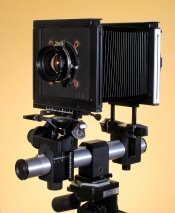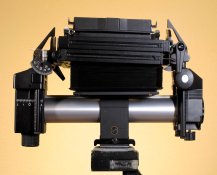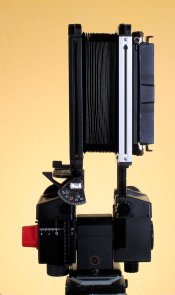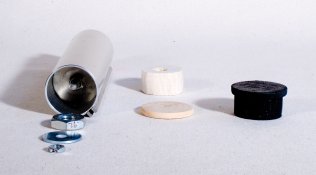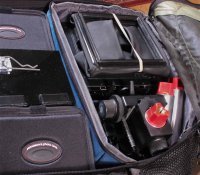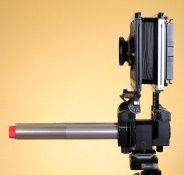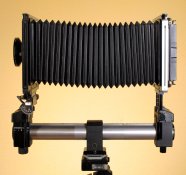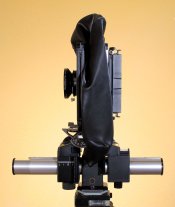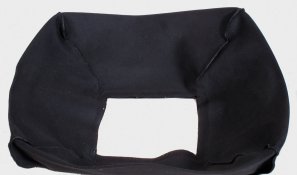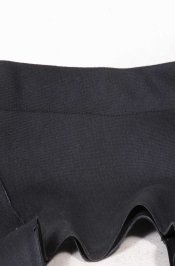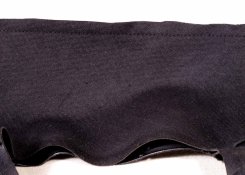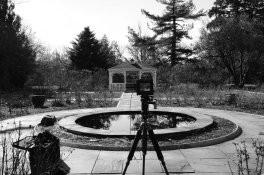Neil Poulsen
Member
- Joined
- May 28, 2005
- Messages
- 525
- Format
- 4x5 Format
Many years ago, I considered using Sinar 4x5 F cameras. Being interested in landscape, fine art, and architectural photography, I’ve always carried my equipment in a backpack. But looking at Sinar’s recommendation for backpacking Sinar F cameras (2nd photo), I quickly discarded the idea. Not only is the “collapsed” camera oversized and clumsy for a backpack, setting them up and taking them down requires multiple steps. This is fine for a studio, but it wasn’t suitable for me to use in the field.
The point of this thread is to demonstrate how a Sinar F can be customized to make it viable for easy use in the field.
More recently, I had an opportunity to purchase some Sinar Norma equipment at a swap meet for quite a good price and went home with a Norma 8x10 and 4x5. This got me to experimenting, and I devised a (reversible) way to convert a 6” extension rail into a short base rail. It’s a simple matter of immobilizing the red knob so that extensions can be attached. Using this base rail, the collapsed camera is much easier to keep in a backpack. (See 3rd photo.) In fact, the first image shows the camera with a single 6” extension added to the short base rail.
The last image shows how one can immobilize the red knob. The large nut is used merely as a spacer and is inserted first. The fender washer goes over the top of the “spacer” on the post inside the extension. The third is a 6 mm nut that screws onto the post after inserting both the spacer and the washer. You can see how tightening the 6 mm nut can indeed immobilize the red knob on the opposite side of the 6 inch extension. It's nice to have an end cap on the short base rail. Sinar made such an end cap for a (longer) base rail like this one, but they're rare. As shown, one can also make one from wood using a short piece of dowel and a wood disk.
For my purposes, this simple alteration makes a Sinar F 4x5 viable as a field camera. It can easily be stowed in a backpack. From the 5th photo, the camera, both bellows, and the extensions all fit into a fairly constrained space. I always install a quick release tripod plate on my cameras. So setup of this modified system occurs in the single motion of removing the camera from the backpack and placing it onto the tripod head.
Two additional comments on equipment. This camera includes the original Sinar F clamp, which is much preferable to the more recent, taller clamp usually seen on Sinar cameras. Being taller, the later clamp more prone to tuning fork vibrations while the camera’s in use. Their length also makes the camera too long to stow conveniently in a backpack.
As to the second comment, you may note that the rear standard on this camera is different. It was designed for use on a copy camera. To be on axis with the F2 front standard requires that it be raised by about 1.5”. I like using it, because I can then effect, or at least fine tune. “front” rise/fall using just the rear standard. This particular rear standard also does not have tilt, swing, nor shift. (It’s sufficient to have these movements only on the front.) I like this feature as well. It lessens the chance that the rear standard will be out of alignment with the front.
As for the F2 front standard, I had incorrectly assumed that they were manufactured only with the longer 5" risers intended for 8x10 cameras. But obviously, that's not the case. The F2 short risers aren't as long as those on a F or F1 front standard (2 3/8" versus 3"); but, they're sufficiently long for field work.
But using this rear standard is just a personal preference, and they’re hard to find. The regular Sinar F rear standard works very well. In fact, many will likely prefer it, because it includes tilt, swing and shift.
The point of this thread is to demonstrate how a Sinar F can be customized to make it viable for easy use in the field.
More recently, I had an opportunity to purchase some Sinar Norma equipment at a swap meet for quite a good price and went home with a Norma 8x10 and 4x5. This got me to experimenting, and I devised a (reversible) way to convert a 6” extension rail into a short base rail. It’s a simple matter of immobilizing the red knob so that extensions can be attached. Using this base rail, the collapsed camera is much easier to keep in a backpack. (See 3rd photo.) In fact, the first image shows the camera with a single 6” extension added to the short base rail.
The last image shows how one can immobilize the red knob. The large nut is used merely as a spacer and is inserted first. The fender washer goes over the top of the “spacer” on the post inside the extension. The third is a 6 mm nut that screws onto the post after inserting both the spacer and the washer. You can see how tightening the 6 mm nut can indeed immobilize the red knob on the opposite side of the 6 inch extension. It's nice to have an end cap on the short base rail. Sinar made such an end cap for a (longer) base rail like this one, but they're rare. As shown, one can also make one from wood using a short piece of dowel and a wood disk.
For my purposes, this simple alteration makes a Sinar F 4x5 viable as a field camera. It can easily be stowed in a backpack. From the 5th photo, the camera, both bellows, and the extensions all fit into a fairly constrained space. I always install a quick release tripod plate on my cameras. So setup of this modified system occurs in the single motion of removing the camera from the backpack and placing it onto the tripod head.
Two additional comments on equipment. This camera includes the original Sinar F clamp, which is much preferable to the more recent, taller clamp usually seen on Sinar cameras. Being taller, the later clamp more prone to tuning fork vibrations while the camera’s in use. Their length also makes the camera too long to stow conveniently in a backpack.
As to the second comment, you may note that the rear standard on this camera is different. It was designed for use on a copy camera. To be on axis with the F2 front standard requires that it be raised by about 1.5”. I like using it, because I can then effect, or at least fine tune. “front” rise/fall using just the rear standard. This particular rear standard also does not have tilt, swing, nor shift. (It’s sufficient to have these movements only on the front.) I like this feature as well. It lessens the chance that the rear standard will be out of alignment with the front.
As for the F2 front standard, I had incorrectly assumed that they were manufactured only with the longer 5" risers intended for 8x10 cameras. But obviously, that's not the case. The F2 short risers aren't as long as those on a F or F1 front standard (2 3/8" versus 3"); but, they're sufficiently long for field work.
But using this rear standard is just a personal preference, and they’re hard to find. The regular Sinar F rear standard works very well. In fact, many will likely prefer it, because it includes tilt, swing and shift.
Attachments
Last edited:





